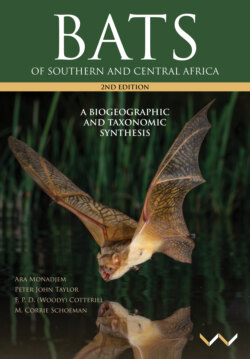Читать книгу Bats of Southern and Central Africa - Ara Monadjem - Страница 56
На сайте Литреса книга снята с продажи.
ОглавлениеEpomophorus anselli Bergmans and van Strien 2004
Ansell’s epauletted fruit bat Data Deficient
Description: Epomophorus anselli is a medium-sized bat with an estimated mass of about 70 g, and is midway in size between the smallest and the largest representatives of its genus. The pelage is light sandy-brown. Adult males are larger than females, and may be distinguished by a broader muzzle with a folded upper lip and the presence of shoulder epaulettes. These epaulettes are pockets containing long, white fur that can be erected to display prominent white shoulder patches. At rest, these patches disappear as the fur is retracted into the pocket. The ears have a patch of white fur at their base. The muzzle is dog-like.
For a fruit bat, the skull is relatively delicate with fairly weak zygomatic arches. In lateral profile, the rostrum and interorbital region are flat, while the parietal region is deflected downwards. The sagittal crest is absent, while the lambdoid crest is weak. There are six narrow palatal ridges present, two beyond the last molar. Only the fifth and sixth ridges are divided by a narrow groove (Bergmans and van Strien 2004). The dental formula is 2121/2132 = 28.
Key identification features: The combination of white patches at the base of the ears and shoulder epaulettes (males) separates Epomophorus, Epomops and Micropteropus from other fruit bats. Palatal ridges of Epomops and Micropteropus are very different from those of Epomophorus; in the latter there are six narrow ridges (five thick ridges in Micropteropus and Epomops). Adult male E. anselli can be distinguished from the larger male E. wahlbergi and E. crypturus by size (FA < 80 mm; in adult male E. wahlbergi and E. crypturus FA > 80 mm). Epomophorus labiatus and E. grandis are smaller (FA < 70 mm) and in E. grandis the second to sixth palatal ridges are divided (second to fourth ridges not divided in E. anselli).
Echolocation call: This bat does not echolocate.
Distribution, habitat and roosting: Epomophorus anselli is known from two specimens collected in Kasungu National Park, Malawi; two specimens collected from Karonga, Malawi, are suspected to belong to E. anselli (Bergmans and van Strien 2004). More recently, one specimen was recorded from Upemba National Park, DRC (van Cakenberghe et al. 2017). Epomophorus anselli is probably more widespread than currently known, and should be searched for in eastern Zambia and elsewhere in southern DRC, northern Mozambique and southern Tanzania. The type specimen for E. anselli is from Kasungu, Malawi (ZMA 21.693b, Holotype).
Nothing is known about the habitat and roosting habits of this species. Both specimens at Kasungu National Park were captured in miombo woodland at an elevation of approximately 1,000 m.
Extralimital: Epomophorus anselli is endemic to southern Africa.
Foraging ecology: There is no information on the diet or foraging behaviour of this species.
Reproduction: No reproductive information is available.
| External measurements (mm) for Epomophorus anselli, males and females presented separately | |||||||||||
|---|---|---|---|---|---|---|---|---|---|---|---|
| Mean | Min | Max | SD | N | Mean | Min | Max | SD | N | ||
| Males | Females | ||||||||||
| Mass | - | - | - | - | - | Mass | - | - | - | - | - |
| FA 1 | 77.4 | - | - | - | 1 | FA 1 | 66.5 | 64.0 | 68.0 | - | 3 |
| Total | - | - | - | - | - | Total | - | - | - | - | - |
| Tail | - | - | - | - | - | Tail | - | - | - | - | - |
| Tibia | - | - | - | - | - | Tibia | - | - | - | - | - |
| Ear | - | - | - | - | - | Ear | - | - | - | - | - |
| CI | - | - | - | - | - | CI | - | - | - | - | - |
1 Bergmans and van Strien (2004)
SYSTEMATIC NOTES
2004.Epomophorus anselli Bergmans and van Strien, Acta Chiropterologica 6: 249–268.
There is confusion regarding the taxonomic relationships within the small-sized bats of the genus Epomophorus (see the E. labiatus account for further details). The specimens now referred to as E. anselli were originally identified as an isolated Malawian population of E. anurus (see Bergmans and van Strien 2004), which has since been synonymised with E. labiatus (Bergmans 1988).
1 Bergmans and van Strien (2004)
